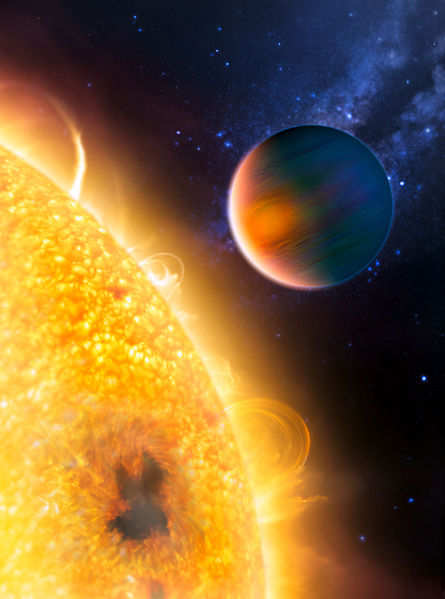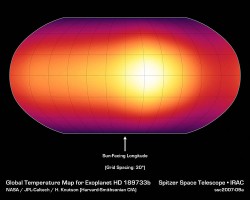HD 189733b is a Jupiter-sized extrasolar planet orbiting a yellow dwarf star. Due to its size and compact orbit, HD 189733b is one of the most studied extrasolar planets. HD 189733b shares many similar characteristics as HD 209458b (a.k.a. “Osiris,” as I reported in a UT article yesterday), and similar techniques have been used to analyse the spectral emissions from both parent stars. Although HD 189733b’s atmosphere isn’t thought to be evaporating like Osiris’, atmospheric gases extend far beyond the planetary “surface” allowing stellar light to pass through, giving astronomers a peek into what chemical compounds surround HD 189733b. From this analysis, scientists have deduced that water and methane is contained in the atmosphere; the Spitzer space telescope has even mapped the temperature distribution around the globe. Now, an Indian researcher has published work indicating a thin layer of particles exists in the upper atmosphere of HD 189733b. So what is the weather like on HD 189733b?
HD 189733b was discovered in 2005 and orbits a star in a binary system called HD 189733 in the constellation of Vulpecula. As the main star in the binary is a variable star (due to the transit of HD 189733b, periodically eclipsing the star), it has been designated with the variable name V452 Vulpeculae. The star system itself is located near the Dumbell Nebula, approximately 62 light years from Earth. As the star is relatively dim, as the exoplanet transits the star, there is an appreciable decrease in luminosity (of about 3%), creating the ideal conditions for the atmosphere of HD 189733b to be studied.
This exoplanet is approximately the same mass (1.15 ± 0.04 MJ) and radius (1.154 ± 0.032 RJ) as Jupiter, but it orbits very close to its parent star (~0.03 AU) so it is known as a “Hot Jupiter.” Due to the water/methane mix in the planet’s atmosphere, it is believed HD 189733b may have a blue hue, much like the colour of Uranus.
In 2007, the Spitzer Space Telescope observed HD 189733b and compiled a temperature map of the planet, showing that the equator was much hotter than the poles. Astronomers were also able to deduce that the atmosphere contains iron, silicate and aluminium oxide particulates. In new research by Sujan Sengupta from the Indian Institute of Astrophysics in Bangalore, it appears that these particles may collect in the upper atmosphere, forming a thin haze. This tentative conclusion was reached after careful examination of the polarization of emission from the star as HD 189733b transited. Preliminary results suggest there is a thin, reflective cloud in the exosphere.
So what is the weather like on HD 189733b? Hot and cloudy.
Source: arXiv Blog
Paper: arXiv:0807.1794v1 [astro-ph]



Hi, may I ask, could Mercury once have been a hot Jupiter of which now only the solid nucleus is remaining? If so, what’s the time-frame to lose the atmosphere?
Cheers.
I doubt Mercury could have been a gas giant. Gas giants are believed to form in the outer parts of a solar system. A star the size of our sun would have easily grabbed the gasses from Mercury’s atmosphere to use in its own fusion. Just my opinion.
I assume the obvious answerto the weather question is simply: hot.
There.
Did I save money on research?
^^ Yes, but as for the hundreds of gas giants we’ve found tightly orbiting their stars, they believe they were formed far out and migrated inward. Mercury could have done the same long ago and its atmosphere has simply been burned off.
And the name, HD18973B… come on. Can we start naming the extrasolar planets that we’ve got good data on, not just doppler wobbles?
Nobody can remember these computer generated star classifications + order of planet discovery as a name.
Mike, Tyler,
thank you for your thoughts.
Jupiter is believed to have a solid core. Mercury may have originated further from the sun and been catapulted into a closer orbit in the days of the Great Celestial Pool Tournament. I suspect that the sun would have sucked up the atmosphere fast.
But if Mercury was close from day one, indeed no gases may have formed at all. Just some thoughts.
Good idea about naming the interesting exoplanets. Why not use existing names from well known SF? HHG2G and so, that would be fun!